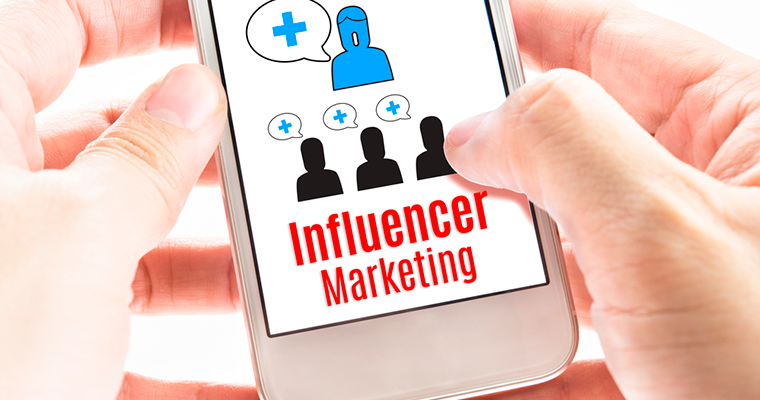Every minute of every day, people send over 347,000 new tweets on Twitter, post almost 50,000 photos to Instagram, upload 300+ hours of video to YouTube and share over 31 million posts on Facebook. The social media world is evolving so quickly, you’d have to be superhuman to keep up.
The worst thing about social media is also the best thing about social media—it allows information to spread like never before. When people find content they’re interested in, they repost, reblog, and retweet it, sending it rippling from person to person in their social sphere.
The person at the center of the biggest ripples is someone we call an influencer—someone recognized as an authority in their niche, whose thoughts and opinions spread like wildfire through the thousands, or even millions, of people who follow them.

A single word of endorsement from a prominent influencer might mean thousands of new hits to your website and hundreds of leads, whereas a scathing review might mean a staggering drop in your followers.
In this post, we’ll look at the basics of influencer targeting and the tools you need to keep up in our noisy digital landscape.
Why Influencers Should be Your #1 Target
Inbound marketing is always about your customers, but sometimes the best way to connect with the people who haven’t heard about your business isn’t to approach them directly. Here’s five reasons why it pays to win new leads through an influencer (with supporting stats by Hive):
1. They Have Huge Reach
90% of the impact online stems from just 3% of social media users. While you need to be playing the long game of building trust and winning leads through content marketing, earning the advocacy of a key influencer might jumpstart your following.
2. They Have Built-in Trust
Not only do influencer audiences inherently trust their advice, but they’re also more receptive to content from a human being (as opposed to a brand). Only 22% of customers trust ads and 27% trust branded content, whereas 51% trust an influencer’s endorsement.
3. They Help You Keep up with Current Trends
It’s easy to get lost in the fluff content floating around the web, but key influencers tend to be choosier with the information they endorse—that’s how they earned their audience’s trust in the first place. By paying attention to what they say, you’ll keep abreast of the latest trends in your industry. No wonder 74% of marketers rely on Influence Marketing.
4. They Give Your Content Direction
Without a well-developed audience, it’s tough to know what your customers really want from your content. Keeping a pulse on the content your industry craves will help you tailor your content to meet their demand, which in turn can boost your conversions by anywhere from 3–10x.
5. They’ll Help You Trail Blaze
70% of people want to learn about products through content instead of advertising, but that number drops significantly if you’re parroting the same words as everyone else. Getting inspired by an influencer or, even better, partnering with an influencer, and created never-before-seen content that sparks new conversations is the way to start establishing yourself as an influencer, too.
What to Look for in an Influencer
Katy Perry has 88.9 million Twitter followers and PewDiePie has more than 44 million subscribers on YouTube, but unless your content specifically deals with pop music/fashion or video games, these probably aren’t the influencers that will drive qualified leads to your doorstep.
That’s why it’s important to identify what the goal of your influencer marketing strategy is before you approach them. Compile lists organized by category that you can easily consult in the future if you need to change your strategy or try a different approach.
Here’s some questions you should consider:
- Is My Content Worth Sharing and Promoting by Influencers?
You’re probably not surprised to hear this, but you likely won’t be promoted by virtue of good looks alone. Influencer targeting, as with all aspects of social media outreach and content marketing, begins with having high-quality content that’s worth sharing. If you don’t have a repertoire of solid content to start with, you’re probably not ready for influencer targeting.
- Do I Have an Ideal Influencer Profile?
KISSmetrics takes a brilliant approach to influencer targeting, by first creating an ideal type of influencer (similar to a customer persona). You’ll want to pre-define the genres, niches, and topics your ideal influencer specializes in, and figure out which personality types you wouldn’t mind collaborating with. This will help you track down influencers that will truly complement your business.
- Who are My Top Prospects?
Next, it’s time to compile a list of your top prospects. Use influencer targeting software (discussed below) to find all the top names in your target niche. Next, figure out where they publish and get a good feel for their existing content.
When you’ve done your research on a prospective influencer, you’ll be able to better tailor your content to appeal to them on the appropriate social channels.
1. How Would I like This Influencer to Impact My Business?
Knowing what your goal is makes influencer outreach much easier. For example, you might be after lead generation or increased sales, in which case you should look for influencers with a strong conversion history, even if they don’t have as many followers. Or maybe you’re looking for more brand awareness and engagement, in which case you’d try to connect with someone with a large number of followers that would be excited to promote your content.
2. Do I Have Influencers in a Variety of Different Mediums?
Rarely do you want to exist in only one circle, which means that you need influencers across a variety of different platforms. For example, a prominent blogger may not be as active on Twitter as another influencer, while a big name on YouTube might not have much written content to offer.
3. Are There Already Influencers in My Corner?
Finally, it’s possible that a big influencer is already onboard with your services, and it will pay to reach out to them. Use an all-purpose tool like BuzzBundle (disclaimer: my tool) to search for keywords across all the big social media channels, or use platform specific services like Post Planner (for Facebook), Follor.me (for Twitter), or Pin Alerts (for Pinterest), to tune in to what’s being said about you.
Note, however, that strong advocacy from someone does not make them an influencer. Influencers have a large following of people who trust their recommendations implicitly, and it’s these people whose goodwill you need to earn.
How to Find the Influencers That Matter to You
No matter your industry, a quick Google search will probably turn up lists of the most prominent movers and shakers. The only problem with this is the lightning fast rate at which social media changes—today’s influencers may not be tomorrow’s.
That’s why the secret to successful influencer targeting lies in software that tracks your mentions, isolate the conversations you need to pay attention to, and deliver analytics that you can act on.
Fortunately, there are a number of software options that you can use to learn what’s being said, who’s saying it, and how you can use that information to better your brand:
1. Awario
(Disclosure: this is my company). This software features smart influencer targeting based on relevancy and overall reach, non-stop monitoring of all social media platforms to keep you instantly informed when your brand is being mentioned, and intuitive analytics that help you plan which influencers own different social niches, and who you should reach out to next.
2. Brandwatch
Brandwatch, like most of the tools on this list, is a robust platform aimed at helping enterprises find influencers and better target their key demographics. It’s a strong analytic tool, that has an intuitive interface and it makes setting up queries very easy. Its price tag, while hefty, is much more manageable for large businesses than some of the other options.
3. Crimson Hexagon
Crimson Hexagon has great visual data delivery, nuanced social media analysis patterns, and (best of all) it “learns” to identify the sentiment behind social media mentions, so that you can gauge whether users are reacting with your brand positively or negatively. Aside from the steep price tag, my only complaint with Crimson Hexagon is that it almost offers too much data—it might be tough filtering through the information to find what’s truly actionable.
4. Synthesio
Synthesio’s interactive data charts make this tool really easy to listen in on, monitor, and report brand mentions. Its design is simple, intuitive, and easy to set up, making optimization a breeze. It’s a little lacking in mobile functionality, but that doesn’t diminish the fact that it offers great in-depth recommendations for brand building.
5. Buzzsumo
If you don’t have the budget for the big, 4-figure solutions listed here, Buzzsumo is a great alternative, especially for start-ups and SMEs. It lets you analyze shared links and key influencers on specific keyword queries. Sadly, Buzzsumo isn’t a one stop shop, which means you’re going to need other services to get the most out of this influencer targeting software.
6. Sysomos
Sysomos makes it easy to gather demographic data from different regions, by letting you filter through countries, and then sort the data into relevant categories that you can use to hone your influencer marketing. This tool’s design is a little less flashy than some of the other enterprise-aimed options mentioned, but it’s not lacking in functionality.
Final Steps: Reaching Out & Building Your Repertoire
Now that you know what you want, it’s time to build the relationships that will last you a lifetime. This means reaching out to your target influencers on the platforms they inhabit and tempting them to engage with content that’s up their alley.
There’s a few ways to go about this, but I recommend:
1. Genuinely Loving Their Content
It’s essential that you’re not just approaching an influencer for good PR while secretly hating their content. It’s ok (in fact, it’s encouraged) to offer a different opinion on a topic that sparks real conversation, but you need to be authentic in your interest.
2. Actively Engaging with Their Updates
The way you show the aforementioned interest is through engagement. Start conversations, ask questions, comment on their blogs, and retweet their insights.
3. Establishing Yourself as a Peer
When you interact with your target influencer, make sure that you’re contributing as much as they are. Share topics relevant to their interests, offer keen insights in their niche, and offer up some of your own experience.
Do this with every one of your influencers, until you have a pool of potential partners to draw from. And remember to keep them informed! Whenever you publish new content or offer a new product that speaks to their interests and appeals to their audience, send them a link. Then you can sit back and watch the ripples spread.
For more information on influencer marketing, check out this free guide by the Content Marketing Institute.
Image Credits
Featured image: weedezign/Shutterstock.com
In-post Image: Twinsterphoto/Shutterstock.com





